05 Apr VVPAT vs Re – Counting and Verification of Votes
(This article is based on General Studies Paper 2 of UPSC Civil Services Examination under the ‘Indian Constitution, Governance and Polity ’ section of ‘Transparent and Fair Election Process and Election Reforms in India’. It also includes inputs from the PLUTUS IAS team.)
Why in the News ?
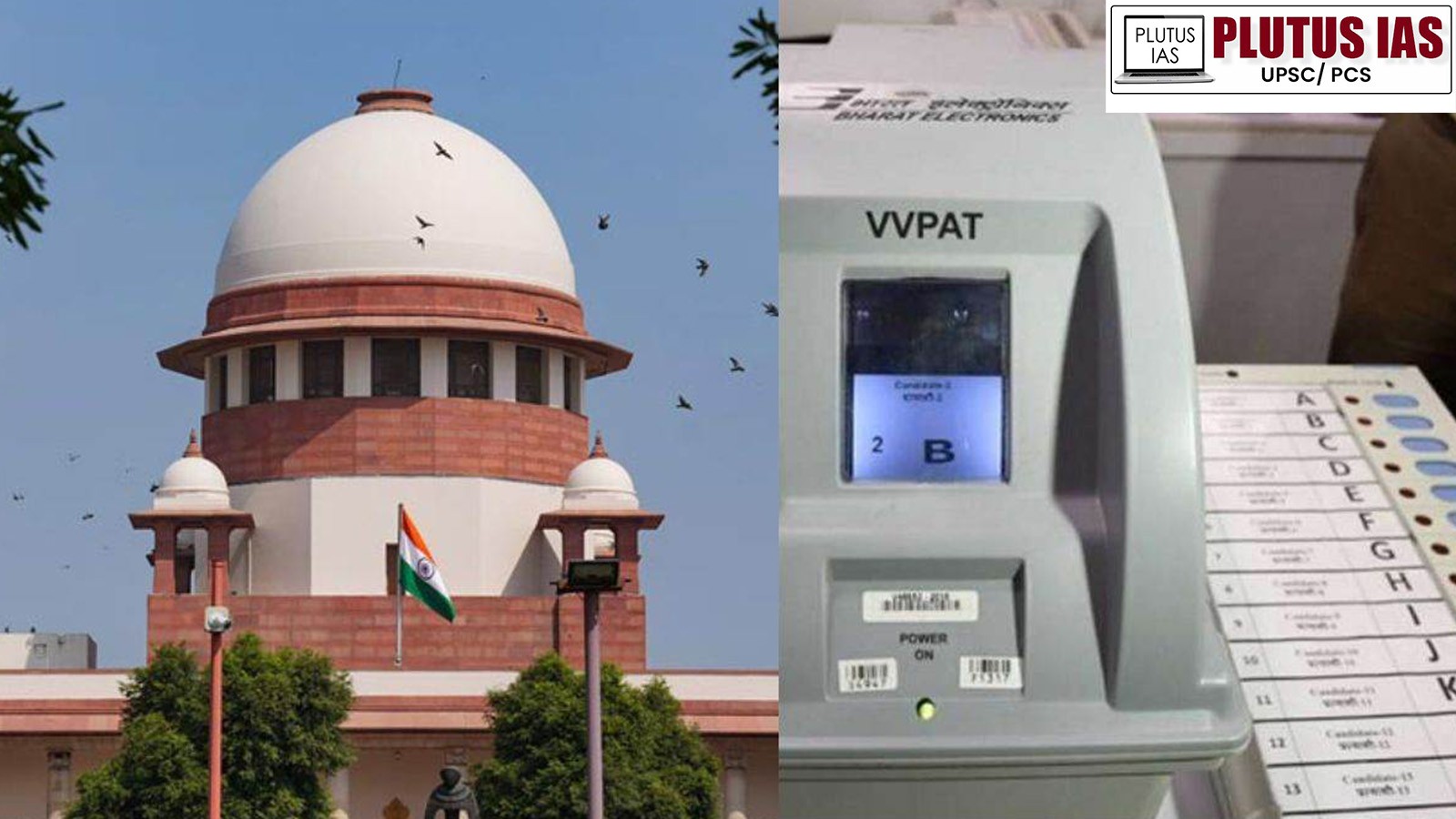
- Recently the various phases and dates of the Lok Sabha Elections 2024 of India have been announced by the Election Commission of India.
- With the announcement of various phases of the Lok Sabha General Elections 2024 to be held in India, a petition has been filed by various political parties in the Supreme Court of India regarding matching of VVPAT slips with the votes cast in EVMs.
- The bench of Justice BR Gavai and Justice Sandeep Mehta of the Supreme Court of India has issued a notice to the Election Commission and the Central Government and sought their response on this petition filed regarding election reforms in India.
- Congress General Secretary Jairam Ramesh has supported this decision of the Supreme Court of India and said that –“100 percent VVPATs should be used to increase public confidence in EVMs and ensure integrity of the electoral process in general elections in India.”
- At present, in the general elections held in India, VVPAT paper slips of 5 random polling stations are matched with EVMs to verify the vote count.
- The Lok Sabha elections 2024 to be held in India is the world’s largest democratic electoral process, in which the voters of India will cast their votes using more than 900 million Electronic Voting Machines (EVMs) and ensure their participation in this electoral process.
Introduction of VVPAT :
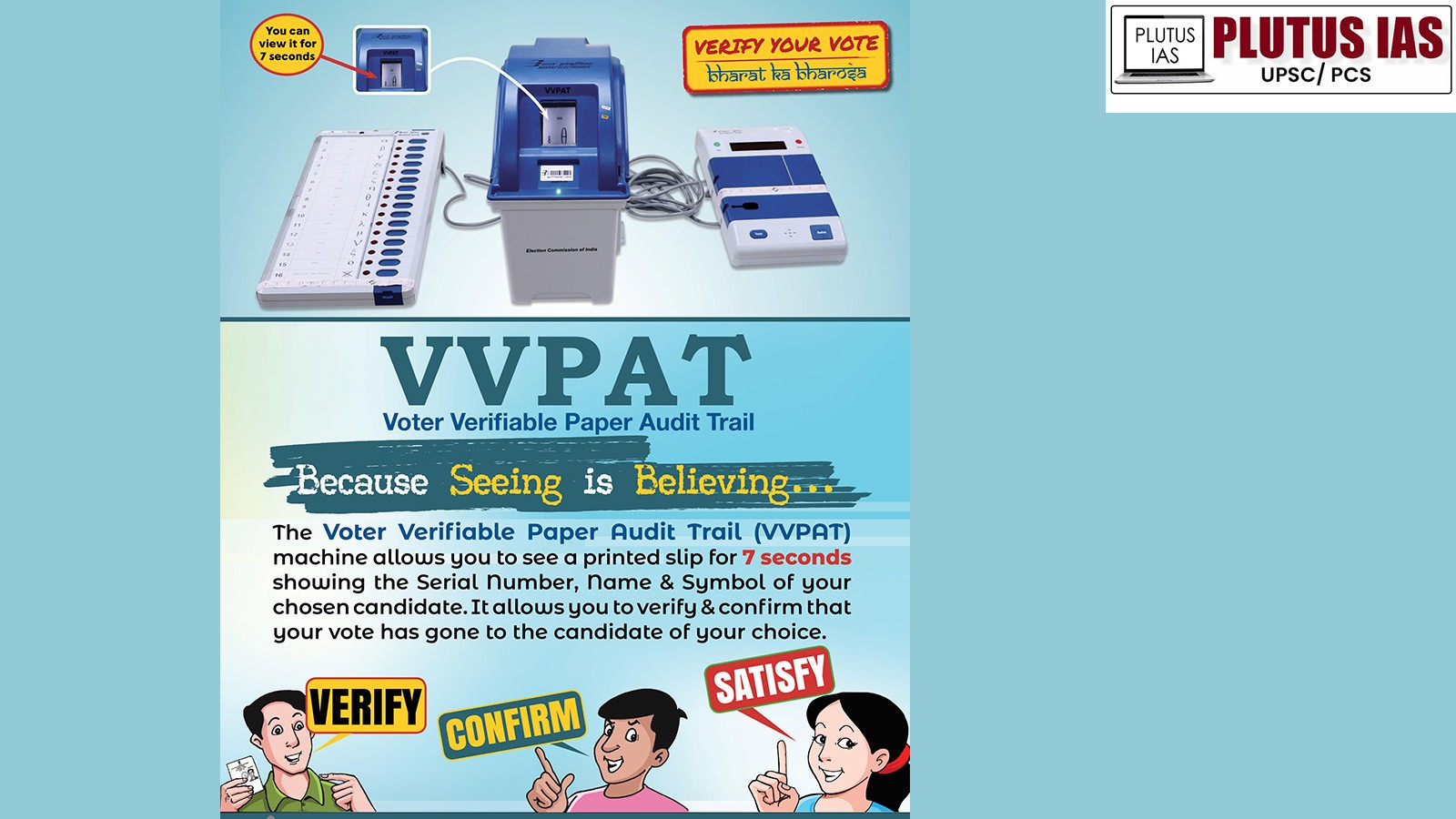
- Full name of VVPAT – Voter verifiable paper is the audit trail that is attached to the electronic voting machines (EVMs) in the election process. When a voter casts a vote using an EVM, the VVPAT prints a paper slip displaying the voter’s choice. This slip is visible behind glass for a few seconds, allowing the voter to verify his choice before depositing it in the box.
- Voter Verifiable Paper Audit Trail (VVPAT) is a method of providing feedback to voters using a ballotless voting system.
- VVPAT is intended to be an independent verification system for voting machines, designed to allow voters to verify that they are voting and to detect potential election fraud or malfunction, and to provide a means to audit stored electronic results. It has been confirmed that their vote has been cast correctly.
- It contains the name of the candidate (for whom the vote has been cast) and the election symbol of the party/individual candidate.
Background of using VVPAT in General elections in India :
- Use of VVPAT in general elections in India The idea of EVMs was first proposed by the Election Commission of India (ECI) in 2010, when several political parties raised concerns about the reliability and security of electronic voting machines (EVMs). ECI conducted several field trials and demonstrations of VVPAT machines in various states and had also sought feedback in this regard from various stakeholders.
- In the year 2013, the Supreme Court of India had directed the ECI to implement VVPAT in a phased manner.
- The Supreme Court of India in the year 2017 had ordered the ECI to use VVPAT along with EVMs in all future elections held in India.
Importance of VVPAT in General elections of India :
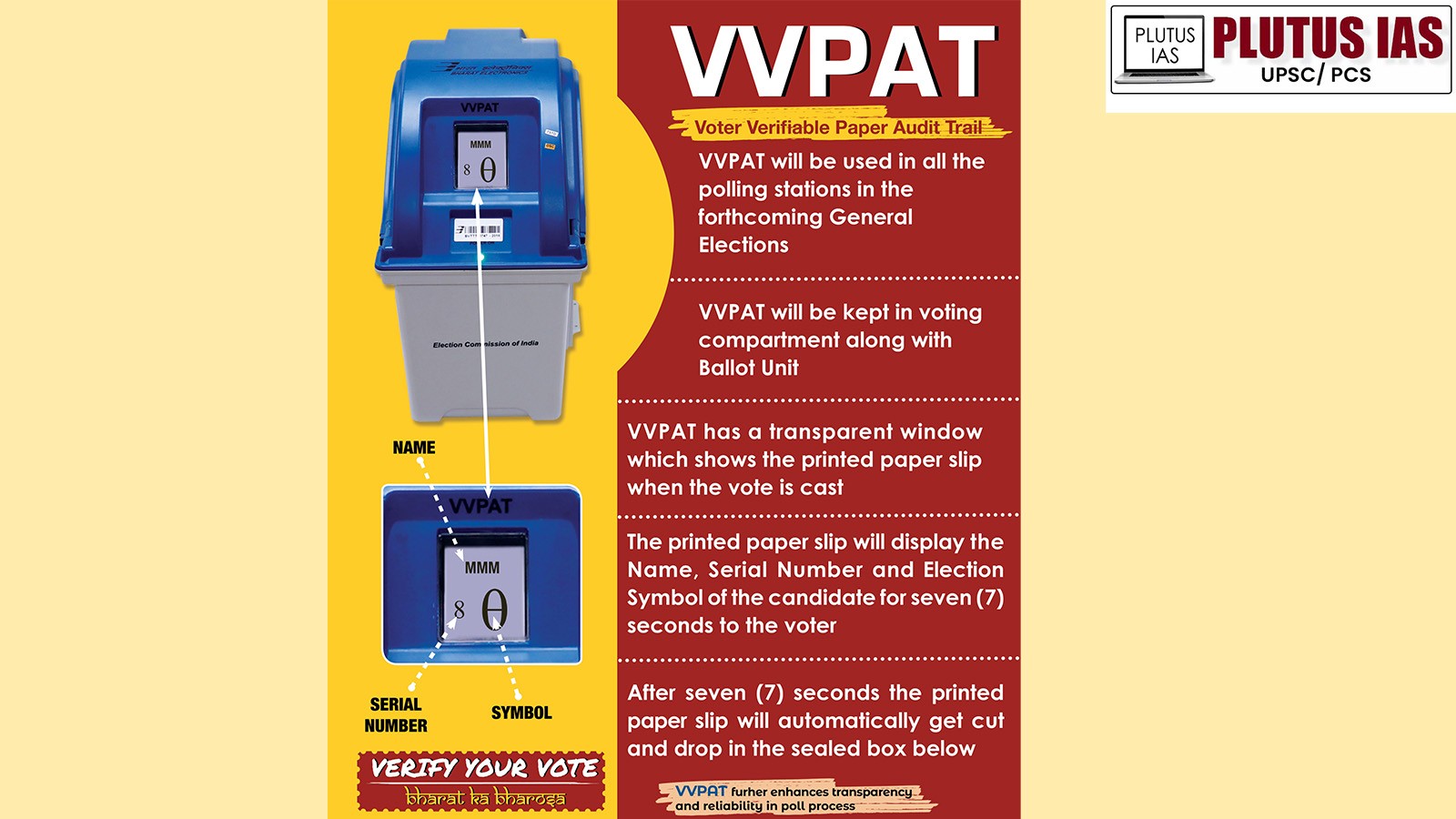
- This allows voters to verify that their votes have been cast as per their preferences.
- This prevents any discrepancy or manipulation in the recording of votes by the EVMs.
- It provides a means of auditing the stored electronic results and enables cross-checking of votes in case of any dispute or doubt.
- This serves as an additional barrier to votes being altered or destroyed by corrupt or malfunctioning voting machines or personnel.
- This enhances the confidence of voters in the electoral system conducted in India and reduces the scope for any allegations or complaints made against EVMs.
Features of VVPAT :
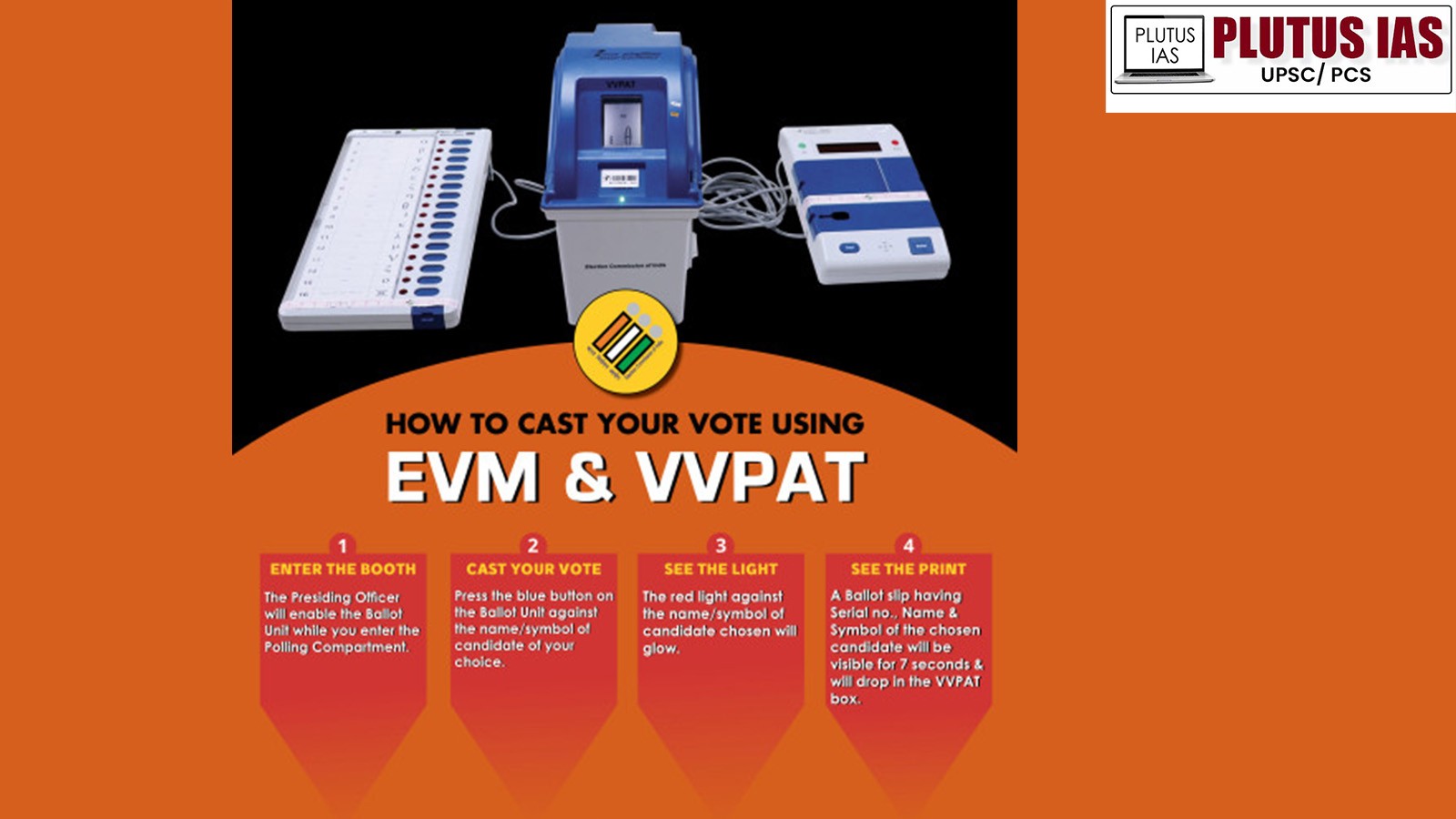
- VVPAT The machine is a printer-like device attached to the EVM. When a voter presses the button on the EVM against the selected candidate, the VVPAT machine prints a paper slip with the candidate’s serial number, name and his election symbol.
- The slip is visible to the voter for seven seconds through a transparent window in the VVPAT machine, after which it is automatically cut and falls into a sealed drop box.
- VVPAT does not require batteries as it runs on a power pack battery.
- Normally a VVPAT takes one hour to count votes.
- VVPAT was first conducted in September 2013 in the by-election to Noksen assembly seat in Tuensang district of Nagaland.
- The VVPAT consists of a printer and a VVPAT Status Display Unit (VSDU).
- In case of recount or audit this slip can be obtained only by the polling officials.
Corrective steps taken by Election Commission of India related to VVPAT :
- ECI has procured over 16 lakh VVPAT machines from two public sector undertakings, Bharat Electronics Limited (BEL) and Electronics Corporation of India Limited (ECIL), at a cost of about Rs 3,000 crore.
- ECI has conducted extensive training and awareness programs for polling officials, security personnel, political parties, candidates and voters on the use and operation of VVPAT machines.
- ECI has introduced a randomization process for allocation and distribution of EVMs and VVPATs to ensure fairness and confidentiality.
- The ECI has ordered that as per the Supreme Court direction, at least one polling station in each assembly constituency will be randomly selected for counting the VVPAT slips along with the EVM votes.
- ECI has also developed a technical protocol for counting of VVPAT slips in case of any mismatch or discrepancy between EVM and VVPAT results.
Challenges related to VVPAT before the Election Commission of India :
- VVPAT machines are prone to technical faults, malfunctions, jamming or printing errors due to various factors such as faulty hardware, software bugs, power fluctuations, environmental conditions, human errors or sabotage.
- VVPAT machines require more maintenance, storage space, security arrangements and transportation costs compared to stand-alone EVMs.
- VVPAT machines increase the time and complexity of the voting process, as voters have to wait for the paper slip to appear and verify it before leaving the polling station.
- VVPAT machines may not be completely effective in ensuring voter verification, as some voters may not check or understand the paper slips properly, or may not report any discrepancies or complaints to polling officials.
- VVPAT machines may not be sufficient to resolve all disputes or doubts about election results, as counting of paper slips is limited to a few polling stations and is subject to human errors or manipulation.
Solution / Way forward :
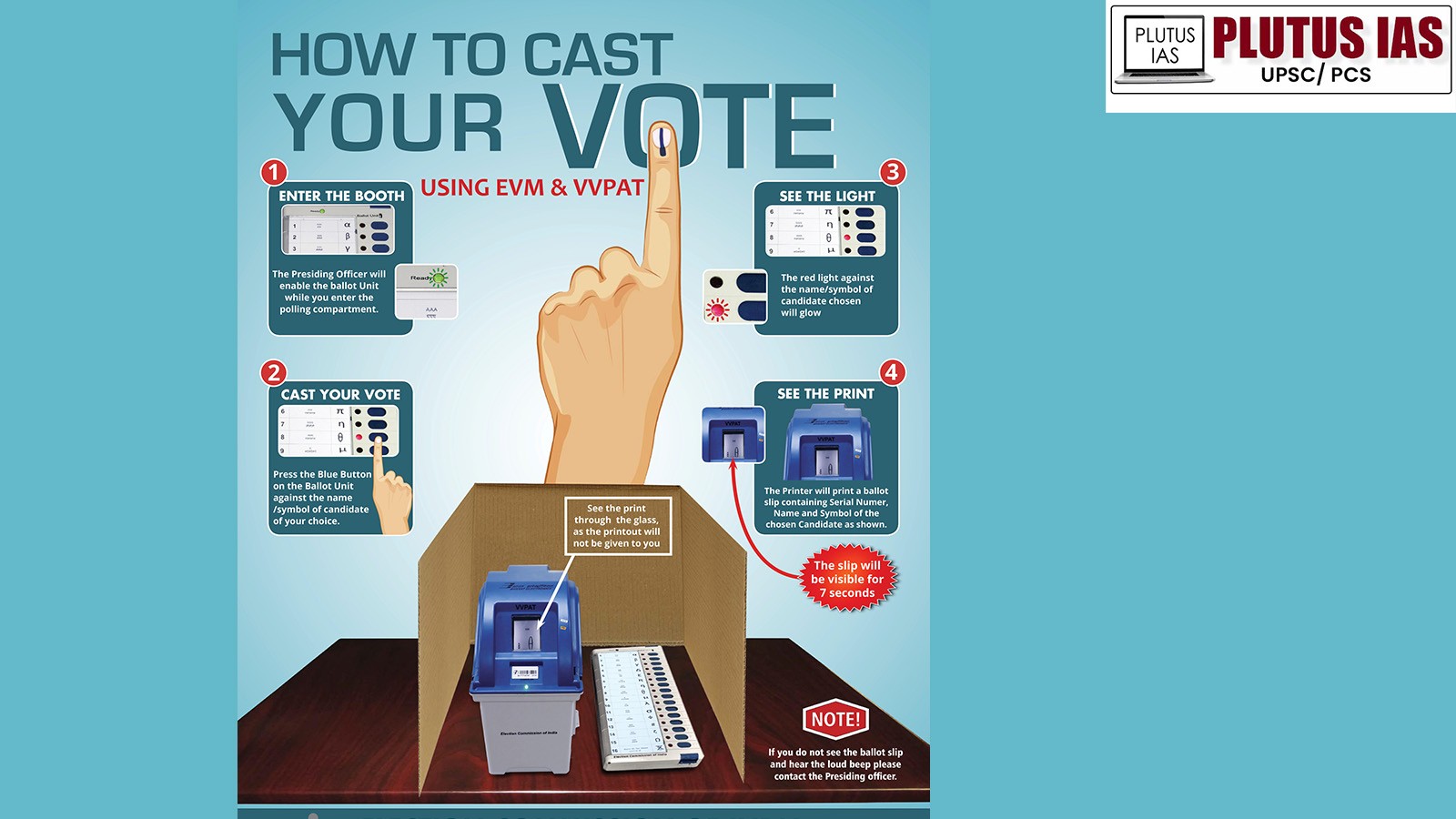
- VVPAT is widely considered a best practice for ensuring the integrity and reliability of electronic voting systems. However, it also presents some technical and operational challenges that need to be addressed carefully. It is important to thoroughly test and evaluate VVPAT systems on a large scale before implementing them in elections in India.
- It is also extremely important to ensure adequate legal and regulatory framework for its use and validation in general elections in India.
- In India, the Election Commission is required to increase the recount sample by selecting certain assemblies of each State/Union Territory to make it more statistically significant or only on those seats where the margin of victory is very small (e.g., total votes This problem can be solved by increasing the recalculation sample. But insisting on a complete recount shows exaggeration and a clear lack of trust in EVMs.
- Verification of a statistically significant sample of VVPAT slips should suffice for elections in India.
- The VVPAT system plays an important role in the electoral system of India, as it enhances fairness, accuracy, transparency and public trust of the voting process.
- India’s electoral process also requires continuous improvement and innovation to address its challenges and limitations.
- ECI should ensure adequate testing, quality control, calibration and certification of VVPAT machines before and after each election and promptly replace or repair any defective or defective machines.
- The ECI should conduct regular training and refresher courses for polling officials, security personnel, political parties, candidates and voters on the use and operation of VVPAT machines and resolve any queries or complaints effectively.
- The ECI should increase random sampling and counting of EVM votes as well as VVPAT slips and adopt a scientific and transparent method for selection of polling stations for this purpose.
- ECI should develop a robust and secure protocol for counting of VVPAT slips and ensure proper documentation and verification of the process in case of any mismatch or discrepancy between EVM and VVPAT results.
- To conduct elections in India in a fair manner, the ECI should also explore other technological solutions or alternatives such as end-to-end verifiable voting systems, blockchain-based voting systems or paper-based voting with optical scanners that would be possible in India. Can replace the VVPAT system in general elections.
Source – The Hindu and PIB.
Practice Questions for Preliminary Exam :
Q.1. Consider the following statements regarding the demand for vote verification through recounting of VVPAT slips in the direction of electoral reforms in India.
- The use of VVPAT in general elections in India was first proposed by the Election Commission of India (ECI) in 2010.
- This prevents any type of malpractice from taking place in elections.
- VVPAT machines in India are manufactured by Bharat Electronics Limited (BEL) and Electronics Corporation of India Limited (ECIL).
- This allows cross-checking of votes in case of any dispute or doubt related to the votes in the election.
Which of the above statement / statements is/are correct?
A. Only 2, 3 and 4.
B. Only 1, 2 and 3.
C. Only 1, 3 and 4.
D. All of these.
Answer – D
Practice Questions for Main Exam :
Q.1. Highlighting the main challenges in conducting a transparent and fair election process in India, discuss how the demand for vote verification through recounting of VVPAT slips is helpful in increasing electoral transparency, fairness and public trust in India ?




No Comments